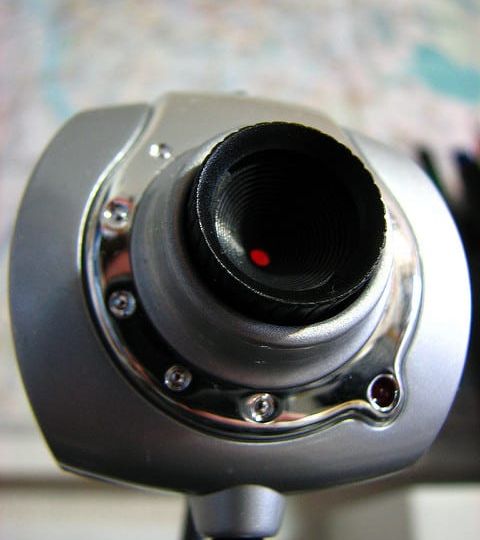
On the St. Olaf campus, because of six publicly accessible live webcams, anyone may see students in their everyday lives. Walking through the Buntrock crossroads on the way to class, sitting in the Quad in the middle of the day and walking into their dorm at night, watched but unaware of the gaze.
St. Olaf is small and insular by design. The College’s architecture reinforces community with communal space. This idea isn’t controversial, and is widely marketed. The three dining options, most notably Stav Hall, are structured to prevent physical distance between students. Couched as being “intensely residential,” students are all but forced to live in dorms, where the furthest person either shares your room or is 20 feet away from you through a thin wall. Residential and academic lounges invite isolation only until another person comes by. Every moment is a performance, because there is no place where eyes may not be on you.
This social pressure and lack of privacy is troubling, but not unknown. Some see it as the price of the unique sense of community St. Olaf offers. The ability to always run into others is part of the College’s brand. However, this promise needs serious re-examination in light of its broadcast outside of the immediate physical space.
The panoptic system is one in which individuals are disciplined by being convinced they can always be seen, and regulated accordingly. This can lead them to regulate their own behavior. St. Olaf’s lack of architectural privacy privileges this kind of system, but the webcams amplify the problem and pose a true threat to privacy.
The webcams, plainly advertised on the St. Olaf website, include Alumni Hall West, facing towards Ytterboe and the wind turbine; Tomson East, including the wind chime memorial and much of the campus green; Tomson West, showing more of the campus green, Mellby Hall, and the Theater Building; Buntrock Plaza, showing the back entrance of the building and yet more of the campus green; the East Quad, showing Regents Hall of Natural Sciences, Holland Hall and Old Main and the “Hi, Mom!” camera, posted outside the Lion’s Pause in the Crossroads of Buntrock Commons.
The outdoor cameras offer a bird’s eye view of a large portion of campus, making their view inescapable for many students as they walk to and from their dorms and class. Individuals appear small, but are identifiable. If someone had the inclination, they could track these cameras and know exactly when another person is leaving or going to any building, making them an ideal tool for potential stalkers or others with malicious intent. Beyond that usage, they serve as a constant reminder that no behavior on the St. Olaf campus is truly private. Beyond the performance for other individuals within an actual physical space, these cameras offer a view to the world’s public.
Very few are actively aware of this level of exposure, as demonstrated by the aforementioned “Hi, Mom!” camera, situated at eye level and advertised as a way for family members to check in on students. When the school advertises the camera, it is suggested as a tool used consciously to directly acknowledge those watching. The suggested image is of a student looking into the camera and waving to their mother, watching on the other side. However, watching the webcam for only a few moments will demonstrate that very few who pass by know they are being watched.
Buntrock Commons’ Crossroads is aptly named. It is centrally located on campus, and a huge number of students pass through it every day. It is immediately outside the Pause and Viking Theater. It is directly underneath the Cage and Stav Hall. It is between many dorms and academic buildings. It is a very common location for political demonstration, including the night-long protest against racial discrimination and inequality that begun the Collective for Change on the Hill’s movement last year. Every time a student stands in this space or walks through it, their face and body are broadcasted live and very few acknowledge it physically when they do.
The entrance to Viking Theater is in its view. A space where people may step out of a film to collect themselves. A space where people may share a private moment because it feels tucked away, unexposed. Lines to Pause events often stretch out the door, likely placing those waiting into the webcam’s view for some time. Exchanges thought to be confined to that space are projected outside its physical context.
Physical context is the essential element lost when these webcams broadcast campus. The “Hi, Mom!” name underlies the justification for such a tool, and its ultimate failure. Those at St. Olaf are accustomed to being seen and it is an essential part of the collective understanding of “community” as it exists here. This camera is then constructed as proof of that community. “Mom” is a stand-in for whoever the investor may be: the person who likely, at least partially, subsidizes a student’s place here and likely played a role in choosing this school over others. If not, it is suggested the person on the other side has some level of investment in observing the school live, and taking in evidence the advertised “community” promise exists. St. Olaf College is a product, and these live webcams are a constant advertisement for it.
This is the fundamental difference between architecture that favors communal space and cameras that open that space up to anyone online who may observe it. Those in the space, even if coerced to be performative, are active participants. They are in it, and all others in it are conscious of their role. Those on the webcam can not be seen and they are not participants. They are voyeurs consuming a product: the ongoing moments of St. Olaf College commodified. And as long as students are within that camera, they are part of the product.

